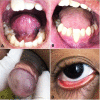Childhood pemphigus vulgaris is a challenging diagnosis
- PMID: 34307224
- PMCID: PMC8294838
- DOI: 10.4322/acr.2021.267
Childhood pemphigus vulgaris is a challenging diagnosis
Abstract
Pemphigus Vulgaris (PV) is an uncommon autoimmune and blistering mucocutaneous disease. Childhood Pemphigus Vulgaris (CPV) is a pediatric variant of PV, which affects children below 12 years, being very rare among children under 10 years of age. CPV has similar clinical, histological, and immunological features as seen in PV in adults. The mucocutaneous clinical presentation is the most common in both age groups. Vesicles and erosions arising from the disease usually cause pain. A few CPV cases have been reported in the literature. This study reports a case of an 8-year-old male patient with oral lesions since the age of 3 years, and the diagnosis of pemphigus was achieved only 2 years after the appearance of the initial lesions. CPV remains a rare disease, making the diagnosis of this clinical case a challenge due to its age of onset and clinical features presented by the patient. Therefore, dentists and physicians should know how to differentiate CPV from other bullous autoimmune diseases more common in childhood.
Keywords: Child; Fluorescent Antibody Technique, Direct; Pemphigus.
Copyright © 2021 The Authors.
Conflict of interest statement
Conflict of interest: The authors have no conflict of interest to declare.
Figures



References
-
- Gürcan HM, Mabrouk D, Razzaque Ahmed A. Management of pemphigus in pediatric patients. Minerva Pediatr. 2011;63(4):279–291. - PubMed
-
- Gonul M, Keseroglu HO. Pediatric Phemphigus. Clin Pediatr Dermatol. 2015;1(1):1–3.

